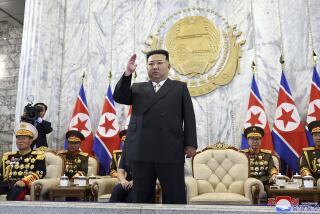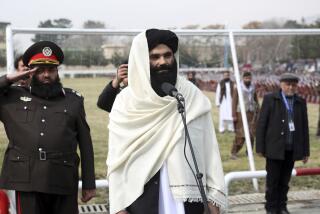Discord Is Drumbeat at Afghan Parade
- Share via
KABUL, Afghanistan — The tanks were squeaky and spewed clouds of smoke. The soldiers marched out of step. Some of the trucks had bullet holes in their windows. The helicopters, though freshly painted, were mostly antiques. And one MIG warplane had crashed the day before, killing the pilot.
But despite the flaws, a military parade Sunday here in the Afghan capital conveyed a strong message about the power of Northern Alliance figures in the interim government.
It also exposed the divisions in Afghan society in the run-up to a grand council meeting in June to choose a new government, and the likely reluctance of the Northern Alliance leaders--such as Defense Minister Mohammed Qassim Fahim, just promoted to the rank of marshal--to surrender the powerful posts they have in the interim administration.
The recently returned Afghan king, Mohammad Zaher Shah, popular among ordinary people and particularly the Pushtuns--the country’s largest ethnic group--was not present, suggesting that he either is irrelevant to Afghan politics or has been shut out by the ethnic-Tajik-dominated Northern Alliance.
The military units marching at the head of the parade were from Northern Alliance strongholds, with no units from cities such as Kandahar or Herat, illustrating the distance Afghanistan has to cover before it can hope to establish a united national army.
The event seemed sure to reinforce doubts among ethnic Pushtuns in Afghanistan about the degree of power held by the Northern Alliance.
The parade, held annually, celebrates the defeat of the country’s Soviet occupiers by moujahedeen fighters in 1989.
Witnesses to last year’s version, under the now-deposed Taliban regime, said there were fewer tanks then and no military uniforms. The parade consisted mainly of Taliban fighters in their favorite military vehicles: pickup trucks.
Before Sunday’s parade, new boots were issued to the soldiers, who marched along with portraits of Hamid Karzai, the interim prime minister.
The parade also further entrenched the cult of assassinated Northern Alliance leader Ahmed Shah Masoud. A giant portrait of him was carried at the front, and tanks bore his picture along with colorful paper flowers.
Just behind Masoud’s portrait came veteran fighters in wheelchairs and on crutches, a sight that seemed to underscore the irony of organizing the gigantic military parade. Though the parade was a celebration of the withdrawal of the Soviet forces, that event actually marked the beginning of more than a decade of bloody civil war, when the moujahedeen who defeated the Soviets started fighting one another for control of Kabul.
Sunday’s procession lacked the clockwork precision and stirring military music of a Soviet or Russian military march in Red Square, but clearly much of the ceremony was borrowed from the Russians.
Afghan television broadcast the event--and Karzai’s participation--at length Sunday night.
One Kabul resident, Sultan Ali, 45, who watched the coverage, was confused as to the parade’s meaning: He thought it was a “celebration on the actions of the president,” meaning Karzai.
“Because of Karzai, there was a celebration today. People wanted to show their happiness because of his leadership,” he said.
The first two military units were from the Panjshir Valley--an area never captured by the Taliban. They were followed by others from the northern city of Mazar-i-Sharif, Jabal os Saraj, Bagram, Kapisa and elsewhere. All are Northern Alliance strongholds.
There was one group from Khowst in eastern Afghanistan, but its members were traditional dancers, not warriors. Toward the end, there were firefighters and airport security guards.
Some of the soldiers who marched waved flowers as they passed Karzai or had blossoms affixed to their guns.
In a speech launching the parade, interim Defense Minister Fahim spoke at length about how Afghans are so strong and brave that they could defeat any invader.
He did not mention the U.S. help Afghanistan received to defeat the Soviets in the 1980s, during the Cold War, or in the recent fight against the Taliban.
“Again these moujahedeen beat Al Qaeda and the Taliban too. All the countries of the world forgot us. We beat them,” Fahim said.
He promised that there would be no more war and pledged to build a national army.
One Kabul resident, Abdul Ghafar, 35, said that even though the military hardware on show was rather old, it still sent a signal to Afghanistan’s neighbors not to interfere in the country’s affairs.
“It’s a sign to them that we are strong and we can defend ourselves,” he said.
More to Read
Sign up for Essential California
The most important California stories and recommendations in your inbox every morning.
You may occasionally receive promotional content from the Los Angeles Times.













